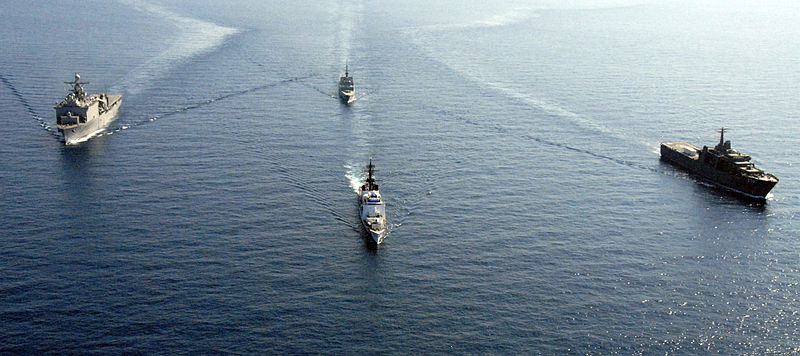Update (October 29, 2015): A spokesperson from the Australian Department of Defence has responded to HKFP’s enquiries and denied that any naval exercises with the Chinese navy has been delayed, saying, “The Royal Australian Navy has a long history of engagement with regional navies and regularly conducts port visits and exercises—including in China. No upcoming engagement activities with the People’s Liberation Army Navy have been delayed, suspended or cancelled.” A previous version of this article under the headline “Australia delays naval exercise with China amid South China Sea escalation” mistakenly suggested that the planned naval exercises will be delayed until the US push is complete, citing news.com.au.
Australia has announced that the naval exercises with China will go on as planned despite its show of support for the United States, after the US navy brought one of its warships near a man-made island in the disputed South China Sea, a move which Beijing strongly condemned.
The Australian Anzac-Class frigates HMAS Arunta and HMAS Stuart were scheduled to sail to Zhanjiang, home to China’s South Sea Fleet, to conduct exercises with the People’s Liberation Army Navy next week.

The Australian government’s announcement that it will go ahead with the exercises as planned came amid rising tensions between the US and China over the South China sea. On Tuesday, the USS Lassen, an Arleigh Burke-class guided-missile destroyer homeported to Yokosuka Naval Base in Japan, came within the 12-nautical-mile territorial limit Beijing claims around its possessions in the Spratly archipelago, signifying the most significant challenge yet to China’s claimed exclusion zones.
However, the Australian Department of Defence minister also said in a statement that the US had acted in accordance with international law and that “all states have a right under international law to freedom of navigation and freedom of overflight”, a right which Australia supported.
Australia also clarified that while it was not involved in the US naval activity, it was interested in maintaining peace and stability in the South China Sea, through which around sixty per cent of Australia’s exports pass.

Around 30 percent of world trade, including half of global oil exports, pass through the sea lanes of the South China Sea, parts of which are also claimed by the Philippines, a US treaty ally, as well as Vietnam, Malaysia, Brunei, and Taiwan.
Freedom of navigation
The US Defence official said that this would likely become “a regular operation” in the South China sea, and that it should not be viewed as provocative in nature.
According to the UN Convention on the Law of the Sea, 12-nautical mile limits cannot be set around man-made islands built on previously submerged reefs. The US Freedom of Navigation programme, which was developed to challenge “excessive claims” to the world’s oceans and airspace, was based on such convention, although the US has not formally ratified the treaty, reports the BBC. Operations in South China Sea territories to which different countries have claims over were conducted by the US in 2013 and 2014.

‘Playing with fire’
People’s Daily China said on Wednesday that there would be serious consequences for the US “playing with fire” in the South China sea. It also said that China’s claim over the territory was backed up with “legal and historical evidence” and reminded the US to stay clear-headed and remember the bigger picture of Sino-US relations.
Liang Yang, spokesperson for the People’s Liberation Army Navy, said that following the US activity, the PLA was now tracking, supervising, and issuing warnings to the US fleet in a “necessary, legal and professional” manner. Liang said that China has an undisputed sovereignty over the territory and its islands and that the navy was acting upon its duty to protect the country’s rights.
China’s Defense Ministry has called it “a coercive action that seeks to militarize the South China Sea region”, according to Reuters. “China will resolutely respond to any country’s deliberate provocations.” It also said that the move was an “abuse” of the freedom of navigation.
